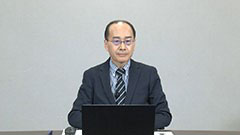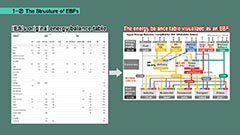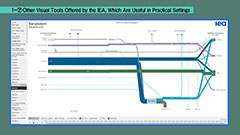- Home
- Our Work
- Types of Assistance
- Technical Cooperation
- Distance Technical Cooperation - JICA-Net
- JICA-Net multimedia-based learning materials Sample Activities
- JICA Infrastructure Management Department; Learning "visualizing" the energy balance - To develop an effective energy efficiency promotion policy -
JICA Infrastructure Management Department; Learning "visualizing" the energy balance - To develop an effective energy efficiency promotion policy -
The material was produced to be used for JICA Knowledge Co-Creation Programs (KCCP)
 This material explains in detail how to conduct data oriented analysis to develop energy efficiency and conservation policies.
This material explains in detail how to conduct data oriented analysis to develop energy efficiency and conservation policies.
JICA-Net multimedia-based learning materials "How to Make Energy Balance Figures, and Analysis Method for Energy Efficiency and Conservation Policies by Energy Balance" (external link) was produced to be used as a lecture material for JICA Knowledge Co-Creation Programs (KCCP) "Promotion of Energy Efficiency and Conservation".
To reduce greenhouse gas which causes global warming, after the Paris Agreement was confirmed in 2015, decarbonizing energy sector is quite important; improving energy efficiency and conservation is expected to contribute a lot to the goal. To develop an effective energy efficiency promotion policy, it is essential to comprehend the overall picture of the energy use in the country and develop policies for identified prioritized sectors. Having said that, data- based assessment is not appropriately conducted in most developing countries.
How to "visualize" numerous information?
 Visualize the energy balance by creating figures from IEA's energy balance table.
Visualize the energy balance by creating figures from IEA's energy balance table.
This material explains how to conduct data oriented analysis to develop energy efficiency and conservation policies with demonstrations; 1. How to make and utilize energy balance figures visualizing IEA's energy balance table, 2. How to make and utilize visualized sector-wise primary energy consumption sheets utilizing IEA's energy balance table.
We intended that, after watching the material, trainees could get necessary data from IEA and analysis it by imitating the way introduced in the material. Because IEA has a lot of country data, using those data is recommended initiatively. However, energy balance table on IEA web site show numerous information, which cannot be easily interpreted. By visualization (creating figures) of energy balance figures, we are able to get the general view and understand the condition and problem of the country. Visualization of sector-wise primary energy consumption is very effective as a tool to quantitatively identify priory sector more clearly, too.
Utilizing the material in various cases
 The material also introduces various tools that are useful in practical settings.
The material also introduces various tools that are useful in practical settings.
In our program, where multiple courses will be held, we made a common core-curriculum to all courses. The content of the material is the most important subject in the core-curriculum and will be utilized to standardize the content of each courses. Concretely, we intend to show trainees the material as an inducement to begin an analysis based on the energy balance and make the way to understand how to do and utilize EBFs more efficiency.
This material will be utilized in various cases not only as the lecture material for KCCP (Including watching the material in a part of curriculum) but also the material for a study meeting in JICA, technology transfer for a counterpart (utilizing for all people who are engaged in planning energy efficiency and conservation policies when technology transfer is introduced) and so on. Making EBFs and identifying prioritized sectors based on assessment of sector-wise primary energy consumption, which are shown in the material, should always be practiced as a starting point when people plan energy efficiency and conservation policies.
We hope that all people who are engaged in planning of energy efficiency and conservation policies watch the material as well as people concerned in JICA. We expect planning and implementing effective policies will be promoted through learning the material.
The samples used in the material are listed below. Please utilize them.
Energy Balance Figures
- Basic model 1: Standard (Dominican Republic) (PDF/264KB)
- Basic model 1: Standard (Dominican Republic) (Power Point/95.8KB)
- Basic model 2: Heat and/or CHP plants included (Uzbekistan) (PDF/268KB)
- Basic model 2: Heat and/or CHP plants included (Uzbekistan) (Power Point/106KB)
- Basic model 3: Nuclear power generation, etc., included (Pakistan) (PDF/277KB)
- Basic model 3: Nuclear power generation, etc., included (Pakistan) (Power Point/109KB)
- Visualized Sector-wise Primary Energy Consumption Sheets (Serbia) (Excel/283KB)
Takeshi Mori
Energy and Mining Group
JICA Infrastructure Management Department
*The Material(s) mainly applied
How to Make Energy Balance Figures, and Analysis Method for Energy Efficiency and Conservation Policies by Energy Balance
This material explains how to conduct data oriented analysis to develop energy efficiency and conservation policies; 1. How to make and utilize energy balance figure utilizing IEA's energy balance table, 2. how to make and utilize primary energy based sector-wise analysis table.
After the Paris Agreement was confirmed in 2015, decarbonizing energy sector is of quite important; energy efficiency and conservation improvement is expected to contribute to the goal much. To develop an effective energy efficiency promotion policy, it is essential to comprehend the overall picture of the energy use in the country and develop policies for identified prioritized sectors. Based on this approach, this material explains how to conduct an energy sector analysis with demonstrations.

- Thematic Issues
- Types of Assistance
- Partnerships with Other Development Partners
- Climate Change / Environmental and Social Considerations
- Evaluations
- Compliance and
Anti-corruption - Science and Technology
Cooperation on Global
Issues - Research
- JICA Development Studies
Program / JICA Chair - Support for the Acceptance of Foreign HRs / Multicultural and Inclusive Community
- About JICA
- News & Features
- Countries & Regions
- Our Work
- Thematic Issues
- Types of Assistance
- Partnerships with Other Development Partners
- Climate Change / Environmental and Social Considerations
- Evaluations
- Compliance and Anti-corruption
- Science and Technology Cooperation on Global Issues
- Research
- JICA Development Studies Program / JICA Chair
- Support for the Acceptance of Foreign HRs / Multicultural and Inclusive Community
- Publications
- Investor Relations
